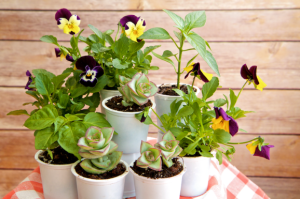

By Ellen Underwood
In the small tract of land between 14th and Linden streets that we call home, there is something beautiful happening. Between the house and our sustainable garden, we have turned a small amount of space into a center for environmental living and learning. Nestled behind the sustainability house, right next to the experiential learning center, the Albright Sustainable Garden is without a doubt my favorite place on campus. This year was my second year running the garden and my second year watching it come to life and die away, of watching it live and breath and slowly fade, only to be reborn again the next year like a phoenix from the ashes. For me, it is a shining beacon of sustainability, a symbol of our individual ability to transition away from consumption to production, from environmental degradation to positive improvement.
Throughout the summer we provide locally grown, organically produced veggies, herbs, and fruits for the Albright community. Leftovers feed us and/or get donated to the local homeless shelter. We learn how to sustainably produce food and have better impacts on the environment 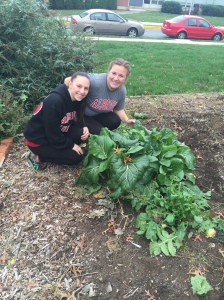 with rain barrels, a rain garden, soil creation, resource re-purposing, and more. My favorite days though, are when we give children from the local elementary school and summer camps tours of the garden. To share the joys of food production and sustainability with younger generations, and to be met with excited, shining, and passionate faces when we do, is an unrivaled feeling for me.
with rain barrels, a rain garden, soil creation, resource re-purposing, and more. My favorite days though, are when we give children from the local elementary school and summer camps tours of the garden. To share the joys of food production and sustainability with younger generations, and to be met with excited, shining, and passionate faces when we do, is an unrivaled feeling for me.
But now, it is fall (and quickly turning into winter!) and the season is over. It saddens me deeply, but we were able to have one last gasp of garden fun at this year’s fall permablitz. What is a permablitz you ask? It is a super fun day of hard work that builds community, engages people in community service, and cultivates environmental stewardship. The word itself is a mixture of permaculture, which is a sustainable farming method, and blitz, indicating lots of hard work in a small time frame! Each year in the fall and the spring we call upon our fellow students to help us prepare the garden for the coming season. With winter creeping in, there was much to be done and we were met with many caring and helping hands to get it accomplished.
First, we had to pull out all the previously productive plants whose lives were now coming to an end (insert sad f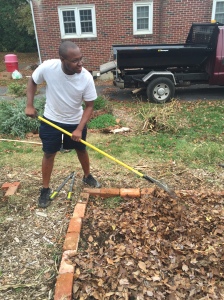 ace here). The next step was to cover the now bare and vulnerable soil from wind and water erosion as well as fertilize it a little for the next season. We did this by placing a layer of leaves collected from the Albright grounds, a carbon source, then a layer of coffee grounds collected from our campus coffee shop, a nitrogen source, and finally a layer of hay from a local feed store in Oley, another carbon source, to top it all off. One of our main goals in the garden is to utilize resources that may have otherwise gone to waste and to source these things as locally as possible. The best part — it’s easy! Another activity was cutting back our native plant rain garden which helps it grow back better each year. The last step of permablitz winterizing was outlining the plots. First, before the permablitz, I went out and expanded the size of the plots since they had inevitably lost surface area throughout the season to the large layer of mulch we had laid down at the spring permablitz.This is especially important because part of permaculture design is to maximize space to make the area of land as productive as possible. Recently a symbolic (and very old) building on Albright’s campus, the White Chapel, was knocked down. It was sad to see it go but we found a way to help it live on. Instead of letting all the old b
ace here). The next step was to cover the now bare and vulnerable soil from wind and water erosion as well as fertilize it a little for the next season. We did this by placing a layer of leaves collected from the Albright grounds, a carbon source, then a layer of coffee grounds collected from our campus coffee shop, a nitrogen source, and finally a layer of hay from a local feed store in Oley, another carbon source, to top it all off. One of our main goals in the garden is to utilize resources that may have otherwise gone to waste and to source these things as locally as possible. The best part — it’s easy! Another activity was cutting back our native plant rain garden which helps it grow back better each year. The last step of permablitz winterizing was outlining the plots. First, before the permablitz, I went out and expanded the size of the plots since they had inevitably lost surface area throughout the season to the large layer of mulch we had laid down at the spring permablitz.This is especially important because part of permaculture design is to maximize space to make the area of land as productive as possible. Recently a symbolic (and very old) building on Albright’s campus, the White Chapel, was knocked down. It was sad to see it go but we found a way to help it live on. Instead of letting all the old b ricks from the chapel waste away at the Albright dump, we took an adventure to get a bunch of them, then used them to delineate the garden plots. This had a few benefits. First, it makes the garden look way more presentable which is important for our tours. As the bricks settle in they will also prevent some erosion in the plots that are on an angle. Now, after the fruits of these labors, the garden is clean, beautiful, and protected for the coming winter season.
ricks from the chapel waste away at the Albright dump, we took an adventure to get a bunch of them, then used them to delineate the garden plots. This had a few benefits. First, it makes the garden look way more presentable which is important for our tours. As the bricks settle in they will also prevent some erosion in the plots that are on an angle. Now, after the fruits of these labors, the garden is clean, beautiful, and protected for the coming winter season.
The garden interns, Aly and Emily, and our garden advisor, Dr. Jennings, teamed with members of various fraternities and sororities, the biology honors club, E.C.O. club, scholarship volunteers, friends, students, faculty, and families, all coming together on this wonderful day to blitz our cherished garden. The result? A strengthening of our Albright community ties, commitment to service that benefits our community’s garden, and active participation in and learning of methods of sustainable living. It is inspiring to see so many people of many backgrounds and interests, all working together in the name of the garden. Some people don’t even know where their food comes from beyond the st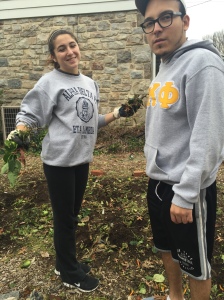 ep of them purchasing it in the grocery store, so connecting people with a sustainable food source happening right in their community, and getting them to participate with it, is exactly the kind of thing our unsustainable world needs. In my own experience, working in the garden is thoroughly therapeutic. It makes me feel healthier and I feel a great pride in cooking food I picked from my backyard only a moment ago. I believe that the more we can connect people with this type of feeling, the more we can begin to change the damaging paradigms that allow us to fall into the trap of industrial agriculture and processed food, the closer we can get to transitioning to more ecologically friendly lives.
ep of them purchasing it in the grocery store, so connecting people with a sustainable food source happening right in their community, and getting them to participate with it, is exactly the kind of thing our unsustainable world needs. In my own experience, working in the garden is thoroughly therapeutic. It makes me feel healthier and I feel a great pride in cooking food I picked from my backyard only a moment ago. I believe that the more we can connect people with this type of feeling, the more we can begin to change the damaging paradigms that allow us to fall into the trap of industrial agriculture and processed food, the closer we can get to transitioning to more ecologically friendly lives.
See below for more great pictures!
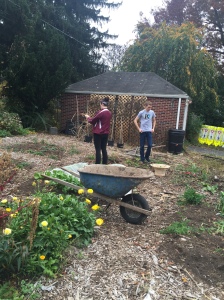

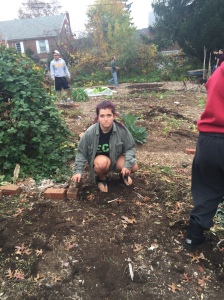
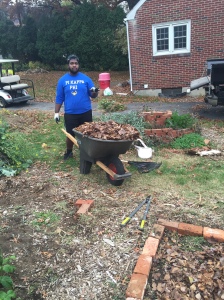
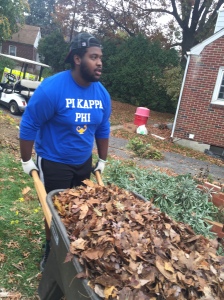
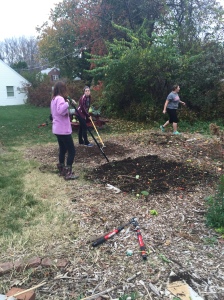
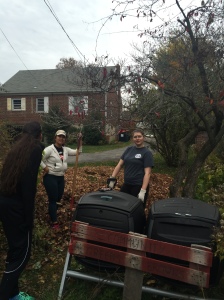
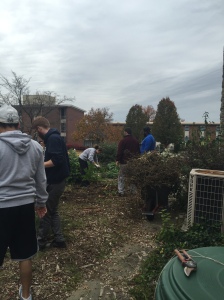
 I got 5 gallon paint buckets and put the dos and don’ts of composting right on the lid for ease of use and from there went knocking on doors! Of the 12 houses contacted, only 5 were willing to participate but I still feel getting even one person to start composting that wasn’t before is a step in the right direction. I met with one individual from each of these households, we reviewed the rules, and I gave them a sheet to hang in their kitchen with more specific rules. The excitement from those who participated was heartwarming and it showed me the value of reaching out to individuals to create the environmental change we need in the world.
I got 5 gallon paint buckets and put the dos and don’ts of composting right on the lid for ease of use and from there went knocking on doors! Of the 12 houses contacted, only 5 were willing to participate but I still feel getting even one person to start composting that wasn’t before is a step in the right direction. I met with one individual from each of these households, we reviewed the rules, and I gave them a sheet to hang in their kitchen with more specific rules. The excitement from those who participated was heartwarming and it showed me the value of reaching out to individuals to create the environmental change we need in the world.













